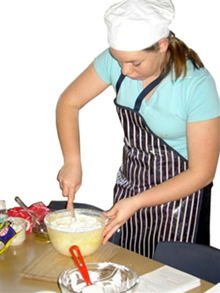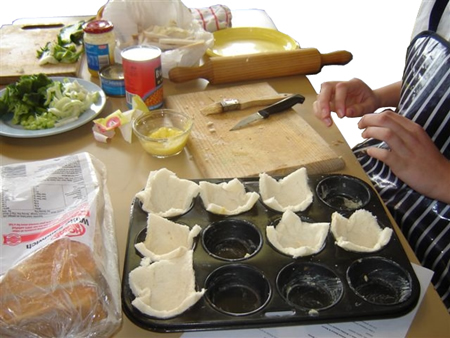Food Bank Recipe Variations

Madeline Smith
Carmel College
Year 13 Food Technology, full-year unit
Teacher: Sandy Goonan
Madeline developed a collection of recipe variations for De Paul House, an emergency housing and family support service. Her client, the service's residents and resources co-ordinator, had suggested she work with the tutors who run cooking classes for residents and they asked her to develop some recipes centred on basic foods.
Madeline first investigated how De Paul House is used and the type of people accessing its services – their cultures, health issues and any traditional foods they have in common. She found that there is little funding for ingredients for the classes – most of the food used comes from the food bank. To ensure that her recipes were appropriate she visited some similar services to De Paul House, to find out how they worked and the sort of food that is usually donated. She also had to consider storage constraints, as this would influence her recipes.
Madeline surveyed the current residents about their cooking experience and food preferences. She was aware that English language difficulties and concerns about confidentiality might result in a reluctance to answer questions so was pleased she got enough responses to help confirm that her proposal was answering a need in the community.
She decided to develop recipes based around the commonly available food bank ingredients, and produce variations for each recipe; this would allow for the use of food that might be available at a particular time. As the supply cupboard is generally well stocked with baked beans, Madeline started her recipe trialling with nachos. After establishing her basic nacho recipe, she tried making it with different beans and with a variety of vegetables which, if available, could be successfully added to make a healthy meal.
One of her key factors was that the food should not only provide a filling meal, but also be what residents enjoy. "If people don't eat it then they're more likely to move to snack type food," she said. After discussing the meals currently cooked in the classes, she decided to also make a pasta bake, spaghetti pies and chile con carne.
A group of classmates was asked to test the meals; they sampled and evaluated each base recipe and its variations.
Madeline wanted people to take her recipes from the classes and use them in their own kitchens, so cost and convenience were important aspects. She compared the prices of food products available in shops and how easy each was to use, and developed her recipes accordingly. For example, a mixture of tomatoes and spices is required for the chile con carne, but for ease of storage and cooking she substituted a packet mix.
She was aware that some residents, lacking the knowledge or skills to adapt a recipe, would be unlikely to cook it if they didn't have the correct ingredients. To overcome this she decided to print each recipe on a card, with variations on the back, so that anyone cooking it could easily find alternatives for a particular ingredient.
Madeline tested her collection at a De Paul House cooking class, where she distributed the recipe variations and taught the attendees how to cook each meal. She reports that her client was happy with the outcome. "She had been a little apprehensive but liked my ideas and was supportive of my programme".
Teacher comment
Madeline's project not only supported sound Technological Practice but encompassed the values of the school and gave her the opportunity to demonstrate these in a practical manner. The nature of her project allowed Madeline to interact with a range of people in the wider school community, giving greater insight to her project, but also gave her definite constraints such as financial, ethical and confidentiality factors that she had to consider throughout.



